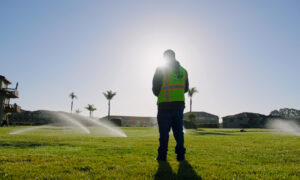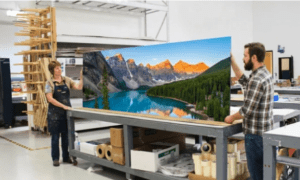Landscaping may still involve soil, sweat, and sharp blades, but technology is changing how the job gets done. If you’re in the business of keeping properties pristine, you already know that efficiency, precision, and results matter. What you may not realize is just how much modern tech can improve all three.
Today’s landscaping professionals are trading in their old-school tools for smarter and more powerful solutions.
Here are six key ways technology is transforming the landscaping industry – and how you can use it to your advantage.
- Smarter Equipment
Equipment is no longer solely measured by horsepower. There are also factors like smart design and ease of use. One of the most notable upgrades in recent years is the move to foot-operated hydrostatic transmissions in commercial mowers. These systems let you control speed and direction with your foot, leaving your hands free to manage steering or focus on navigation. (If you’ve ever tried maneuvering a large mower through tight, complex landscapes, you know how big of a difference that makes.)
You get smoother starts, faster stops, and precise control around trees, beds, and curbs. It’s easier on the body and dramatically improves productivity, especially on properties with a lot of detail work.
Another big win with today’s smarter equipment is the growing compatibility with attachments and modular add-ons. Most of the newer machines are designed to quickly adapt to a variety of tasks. This might include switching from mowing to mulching, or adding an aerator or dethatcher without hauling out a separate piece of equipment. This kind of flexibility means fewer tools to maintain and store, plus far more efficiency.
- Drone Technology
Drones used to be used exclusively for things like real estate photography and security surveillance. But over the past few years, they’ve become useful in landscaping and maintenance applications as well.
With high-resolution aerial views, you can map out large properties in minutes, spot elevation changes, drainage issues, or dying vegetation, and build more accurate proposals for clients. It’s like having an eye on the sky (literally).
For large commercial projects or estates, this is a game changer. You save time, reduce site visits, and make better decisions about grading, planting, and irrigation before a shovel even hits the ground. Some advanced systems even offer thermal imaging, which can help identify irrigation issues or soil compaction from above.
- Automated Irrigation
Water waste is one of the biggest issues in landscaping. It also happens to be one of the easiest to fix with the right tech. Today’s smart irrigation systems use sensors, weather data, and remote controls to deliver just the right amount of water exactly when it’s needed.
No more guessing or setting a timer and hoping for the best. Now you can program irrigation zones based on soil type, sun exposure, and plant needs. Some systems even detect rainfall or freeze conditions and adjust automatically, saving you money and protecting the landscape from overwatering or damage.
Remote management is another win. You or your clients can control the system from a smartphone, making tweaks or shutting things down without ever visiting the site.
- Battery-Powered Equipment (That’s Actually Useful)
Not long ago, battery-powered tools were pretty worthless. You’d get maybe 15 or 20 minutes of battery life and then have to spend an hour re-charging them. But that’s changed in the past few years. New-generation lithium-ion batteries are making handheld equipment like string trimmers, hedge cutters, and blowers quieter, cleaner, and just as powerful as gas-powered options.
This matters more than you think. Battery tools reduce noise complaints, eliminate fuel costs, and cut down on emissions – something more commercial clients and municipalities are starting to require. They’re also lighter and easier to maintain, which means fewer breakdowns and more time spent getting work done.
- Design Software
Landscaping is part art, part science, but it all starts with the design. Gone are the days of hand-drawn sketches on clipboards or vague descriptions over the phone. Today, more landscaping professionals are using advanced 3D design software to create detailed, lifelike renderings of a project before any physical work begins.
These tools allow you to map out every element of a landscape plan, including materials, lighting, hardscapes, softscapes, elevation changes, etc. You can drop in specific plants and visualize how they’ll look not just on day one, but months or years down the road as they mature. (Some programs even factor in seasonal changes, showing clients how their yard will look in spring bloom, summer fullness, or fall color.)
This level of precision is a game-changer. You’re no longer forced to ask clients to imagine what a patio might look like. You can actually show them the exact color, layout, and integration with surrounding elements.
For you, that means clearer communication, better estimates, and fewer changes mid-project. For your clients, it builds trust. They feel more confident in your vision, more willing to invest, and more excited about the end result.
What’s really cool is that the presentation itself becomes a powerful sales tool. When prospects can see their dream yard laid out in full color on a screen – instead of just hearing about it – they’re far more likely to say yes.
- CRM and Business Management Software
Technology can also help streamline the back end of your business. With customer relationship management (CRM) systems and project management software, you can keep track of quotes, schedules, invoices, and team communications, all in one place.
If you’re still juggling spreadsheets or manually following up with clients, you’re spending too much time on admin and not enough time growing the business. Automation can change all of this for the better. Most of the top platforms even include mobile apps, so your crew can clock in and update their status from their phones on site.
The Future of Landscaping
Technology is in the process of elevating landscaping as we know it. The question isn’t whether to embrace new tech – it’s how quickly you’re willing to adapt. Because the companies that leverage these tools now will be the ones leading the industry tomorrow.
So take a look at your current setup. Where are you still working harder than you have to? Chances are, there’s a tech upgrade out there that can save you time and money.



































